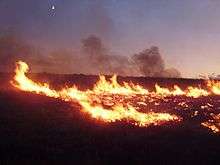Dry thunderstorm

A dry thunderstorm is a thunderstorm that produces thunder and lightning, but most or all of its precipitation evaporates before reaching the ground,[1] and dry lightning is the term which is used to refer to lightning strikes occurring in this situation. Both are so common in the American West that they are sometimes used interchangeably.[2] The latter term is a technical misnomer since lightning itself is neither wet nor dry.[2]
Dry thunderstorms occur essentially in dry conditions, and their lightning is a major cause of wildfires.[3][4] Because of that, the National Weather Service, and other agencies around the world, issue forecasts for its likelihood over large areas.[3][5]
Where dry thunderstorms occur
Dry thunderstorms generally occur in deserts or places where atmospheric water vapor is low. Because dry air tends to absorb liquid water, causing it to change phase into vapor, most of it is absorbed before reaching the ground and form virga. They are common during the summer months across much of western North America and other arid areas.[6]
A thunderstorm does not have to be completely dry to be considered dry; in many areas 0.1 inches (2.5 mm) is the threshold between a "wet" and "dry" thunderstorm.[7]
Hazards
Dry thunderstorms are notable for two reasons: they are the most common natural origin of wildland fires, and they can produce strong gusty surface winds that can fan flames.
Dust storms
Strong winds often develop around dry thunderstorms as the evaporating precipitation causes excessive cooling of the air beneath the storm. This cool air then descends rapidly and fans out upon impacting the ground, an event often described as a dry microburst. As the gusty winds expand outward from the storm, dry soil and sand are often picked up by the strong winds, creating dust and sand storms known as haboobs.
Fires

In areas where trees or other vegetation are present, there is little to no rain that can prevent the lightning from causing them to catch fire. Storm winds also fan the fire and firestorm, causing it to spread more quickly.[8]
Pyrocumulonimbus are cumuliform clouds that can form over a large fire and that are particularly dry.[9] When the higher levels of the atmosphere are cooler, and the surface is thus warmed to extreme temperatures due to a wildfire, volcano, or other event, convection will occur, and produce clouds and lightning. They are similar to any cumulus cloud but ingest extra particulates from the fire. This increases the voltage difference between the base and the top of the cloud, helping to produce lightning.
See also
References
- ↑ Albuquerque Office. "Dry thunderstorms". Fire Weather Topics. National Weather Service. Retrieved December 16, 2015.
- 1 2 "What Is a Dry Thunderstorm?". weather.about.com. About Education. Retrieved December 16, 2015.
- 1 2 "Frequently Asked Questions About Lightning". Severe Weather 101. NSSL. Retrieved December 16, 2015.
- ↑ "Dry Lightning". Wild Fire Assessment System. US Forest Service. Retrieved December 16, 2015.
- ↑ Miriam Rorig; Sue Ferguson; Steven McKay (17 November 2003). Forecasting Dry Lightning in the Western United States (pdf). The 5th Symposium on Fire and Forest Meteorology and the 2nd International Wildland Fire Ecology and Fire Management Congress. Orlando, FL. Retrieved December 16, 2015.
- ↑ Ferguson, Sue A.; Steven, J. McKay; Miriam, L. Rorig; Werth, Paul (May 2007). "Model-Generated Predictions of Dry Thunderstorm Potential" (pdf). Journal of Applied Meteorology and Climatology. 46: 605–614. Bibcode:2007JApMC..46..605R. doi:10.1175/JAM2482.1. Retrieved December 16, 2005.
- ↑ Albuquerque Office. "Dry thunderstorms". Fire Weather Topics. National Weather Service. Retrieved December 16, 2015.
- ↑ "Dry lightning and dry thunderstorms cause the majority of wildfires in the Western US - including California fires.". www.californiagreensolutions.com. California Green Solutions. 2006. Retrieved December 16, 2005.
- ↑ "Pyrocumulonimbus". AMS Glossary. Retrieved December 16, 2015.